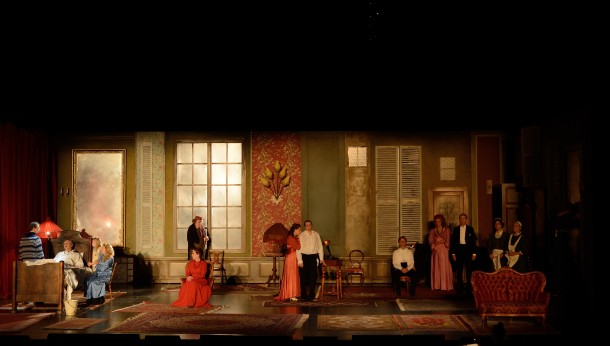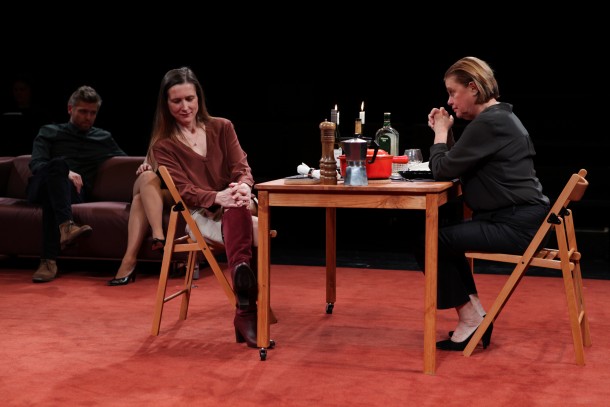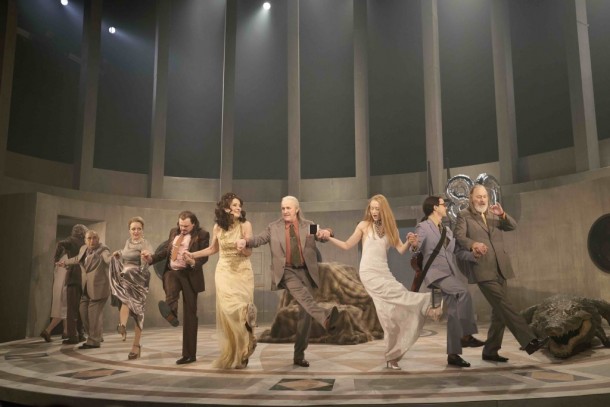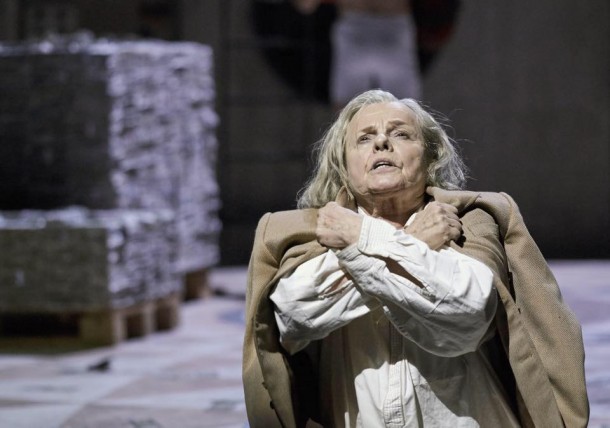Two weeks after the first appearance of his final production for Uppsala Stadsteater, I met with Linus Tunström to discuss his tenure as the theatre’s Intendant. When Tunström arrived in Uppsala in 2008, the theatre had not been known for its formal experimentation or collaboration with foreign directors, but Uppsala Stadsteater is now known for both. A risky choice for the Board and City Council, Tunström was a young director who had never before lead a theatre or an ensemble when he took up the position. Tunström considered the Board’s choice a mandate to produce a more internationally focused, socially engaged, and avant-garde repertoire.
Having directed a critically acclaimed all-male production of Jean Genet’s The Maids in Stockholm at the ripe age of twenty, Tunström then trained with Jacques Lecoq in Paris in the early 1990s. After struggling to keep up with the high standard of performer training, Tunström claims he was invited back for the prestigious second year at Lecoq’s theatre school not because he was a star actor or clown, but as a result of his talent as a creator and innovator. He warmly recalls Lecoq’s warning that every object that falls of its own accord is inherently antitheatrical. Rather, his teacher advised, the theatre maker must account for every action on the stage. His training in Paris informed his newly formed Vertigo Theatre, which toured in the UK and Sweden. Returning to Stockholm, he directed Franz Kafka’s Metamorphosis at Teater Galeasen, a venue celebrated for its experimental productions, followed by a dance theatre piece for the Cullberg Ballet. At this time, Tunström began to work with the scenographer Ulla Kassius, who was investigating the aesthetics of empty spaces and the aesthetic potential of scaled-down designs. This was a creative partnership that lasted for more than ten years and strongly influenced Tunström’s directorial style. Also inspired by Pina Bausch’s Tanztheater, Tunström says that he began directing the construction of atmospheres rather than the “staging of texts,” Despite this suspicion about working with texts, however, Tunström has tackled some of the most challenging works of canonical dramatic literature, including Hamlet, King Lear, and Faust.
In 2010, the financial crisis that had been ripping apart most Western economies for two years finally arrived in Uppsala. As a result of inflation and a squeezed budget, Tunström was forced to make a number of cuts, which resulted in the loss of jobs. Tunström took this financial challenge as an opportunity to reinvigorate the organization, team, and ensemble. As the local economy slowly stabilized, Tunström started inviting international directors from Iceland, Germany, Denmark, the Ukraine, Lithuania, and the UK to work in Uppsala. He carefully picked directors known for their artistic risk-taking and brazen confrontations with well-loved literary classics. A particular example that resulted in outrage from the Swedish critical establishment was Andriy Zholdak’s staging of Thomas Mann’s Mephisto. The Ukranian-born director is known for his grotesque, absurd, or surreal stage imagery, and his privileging of embodiment and visuality over textual fidelity. This scandal was followed by a number of successes. Ingmar Bergman offered Stockholm’s Royal Dramatic Theatre (referred to by Swedes as Dramaten) the rights to the first stage adaptation of his 1982 film Fanny and Alexander. Only a few months after its premiere in Stockholm, Tunström’s own adaption opened to enormous critical acclaim. One critic even asserted that Stockholm had only borrowed what Uppsala owned, making a coded reference to Bergman’s legacy. This was followed by an original adaptation of the much-loved novel Tjuven (The Thief), written by the director’s father, Göran Tunström.

Fanny and Alexander directed by Linus Tunström. Photo courtesy of Uppsala Stadsteatr.
After modernizing the theatre’s branding, another major development was the move to a repertoire. While Uppsala Stadsteater had previously staged one production at a time, Tunström worked with designers and technicians to make it possible to accommodate multiple sets. As a result, the theatre now produces between seven to eight new productions a year on the main stage and up to eighteen productions across its three stages, and ticket sales have risen by 50% over the past five years, while media coverage has increased by an astonishing 400%. Consequently, Tunström has been able to employ as many as seventy-two actors in the theatre’s 2015-16 repertoire. The theatre now caters to more tastes—from large-scale productions of La Cage aux Folles to vanguard stagings of Uncle Vanya, from feminist reworkings of Frank Wedekind’s Franziska to theatrical adaptations from films such as Scenes from a Marriage—and radiates a strong artistic and political energy in a relatively conservative university town.

Scenes from a Marriage directed by Linus Tunström. Photo courtesy of Uppsala Stadsteater.
“Times have changed,” Tunström laments, “over the past nine years in Sweden.” The question of producing political theatre at a state-funded institution is a complex negotiation. As in all city theatres in Sweden, parties across the political spectrum offer equal financial support, and therefore it is not possible to produce a work that openly supports a particular party agenda. That does not mean, Tunström assures me, that the construction of politically engaged theatre is not possible. This notion of the political is one of an aesthetic intervention, a kind of “radical aesthetics,” rather than a theatre that simply subscribes to politics. He chooses texts that are open-ended rather than apodictic, and which have a foundational confrontative idea. Tunström is also attentive to the modes in which the production of new artistic concepts and modes of working have a political resonance. You have to overcome fear—fear of not being in control, of what you don’t know. “This is an existential stance,” he explains. The broad spectrum of productions and the range of aesthetics, styles and forms are intended to combat easy unanimity. “There is no point if a theatre makes a political stand for an audience that is in full consensus.” In the current political climate, where xenophobia and conservatism is on the rise and Scandanavia’s borders are quickly shutting to migrants and refugees, even Uppsala Stadsteater’s production of the well-known musical Cabaret resonates with new political force, a warning against the new rise of European fascism.
Relatedly, over the past year, Tunström—who had worked in the late 1980s on applied theatre projects and social arts programming in London with LEAP and British theatre maker Danny Braverman—has turned the theatre’s attention to wider social engagement. In collaboration with the charity Save the Children, special theatre workshops have been organized for refugee children to meet Swedish youngsters; this offers another approach to engagement with Swedish society. While rejecting message-driven theatre, Tunström is attentive to the modes in which publics perceive spaces of freedom. He is concerned about the dynamic, multicultural, intergenerational make-up of audiences and the theatre as a critical public meeting space that goes beyond standard spectatorship.
Kung Lear
In choosing to direct King Lear (Kung Lear in Swedish) as his farewell production, Tunström was conscious of Peter Brook’s warning that the text is a “mountain whose summit had never been reached.” Rather like Brook’s legendary production with Paul Scofield in 1962 for the Royal Shakespeare Company, Tunström not only focused on the larger political themes of the play, but also carefully considered the nuanced role of family and domestic life. This included several reimaginings of the nuclear family through cross-gendered casting. Most significantly, while the stage was awash with male actors with grey hair, none of them were embodying Lear, a role that has been played by many well-loved alpha males of the modern Swedish stage, including Jarl Kulle, Keve Hjelm, Nils Börje Ahlstedt and Sven Wollter. Against this trend, Tunström cast Marie Göranzon, a company member of Stockholm’s Dramaten, to play the role of the king. In the opening scene, Göranzon appears in a gender ambiguous cotton shift. Piece by piece, however, over the course of the play, she dons a suit and sensible leather shoes. This slow progression into the social lexicon of masculinity is coupled with its progressive undoing as Lear loses his status, authority and wealth. Göranzon, who is equally renowned both for her onstage portrayals of strong female characters and for her robust and highly publicized views on a myriad of social themes, calls attention to what Erika Fischer-Lichte has labeled “perceptional multistability,” which is the shifting of perception between figure and ground, between the actor’s phenomenal body and that of the dramatic character. In her 2008 article “Reality and Fiction in Contemporary Theatre” in Theatre Research International, Fischer-Lichte argues that there is a divergence between the order of representation, the understanding of the semiotics of the actor’s body purely in reference to the construction and articulation of the dramatic character, versus the order of presence, the “unpredictable and even chaotic” associations, memories and imaginations conjured by the actor’s particularity, their being-in-the-world. Teetering back and forth between these two modes of viewing the actor’s body, which compete against one another for dominance and the stabilization of meaning-making, the spectator experiences frustration and even confusion. Because the actor’s body refuses to disappear completely behind the veil of dramatic fiction—a process which one might argue disciplines the actor’s body—the resulting tension is more conducive to performances of gender variance such as the one enacted by Göranzon. If Lear frames the discourse and controls the speech acts, which his daughters inherit and embody, then this casting choice resonates with a broader gender politic that breaks the equation of men with (active) language and women with (passive) corporeality, while refusing to foreclose the problem of power within the nuclear-family structure. This further offers a new reading of the sisters, Regan and Goneril, who move beyond the standard embodiment of “evil” to become pragmatic caretakers to a grumpy, ageing, megalomaniacal father, who oppresses them and makes unreasonable demands on their time and resources. It is this parental oppression that turns to violence.

Kung Lear directed by Linus Tunström. Photo credit: Micke Sandström.
The costumes, tailored and expensive, reflect the hushed luxury of the setting, designed by the German scenographer Bettina Meyer. Dominant colors are pale blues, cool greys, and neutral browns. Only white stands out as a stark contrast to this muted palette. This is worn by Cordelia and Edmund, both played by the tall, pale Emelie Wallberg. Wallberg’s inscrutable and, at times, robotic and emotionless performance is suggestive of Terence Stamp as the enigmatic stranger who seduces men and women in Pier Paolo Pasolini’s 1968 cult classic Teorema. As in Passolini’s film, the erotic encounters with the stranger breakdown hegemonic social roles. Goneril and Regan are not the only characters to fall under Edmund’s spell; Albany is equally attracted by his charm and beauty. While Edmund listlessly indulges in these seductions, his interactions with his father, Gloucester, prove to be the most erotically charged, suggesting more than a filial bond. The double casting of Cordelia/Edmund also opens up new possibilities of interpretation that challenge standard binaries that see Cordelia as inherently good and innocent and Edmund as thoroughly depraved and immoral. If the certainty of Edmund’s ambition and duplicity is destabilized, then Cordelia’s sincerity is also called into question. White is also associated with Edgar, who finds himself clothed only in underpants when he strips off his pale suit on the heath in a moment of self-revelation. The color white then ambiguously resonates with characters who make strong moral decisions (though not necessarily good ones), find a clarity of action, and who inhabit their own agency outside of the precepts of the law and the monarchy. Divorced from easy associations with purity, innocence or death, the radical ambiguity of white functions as a counter-symbol to the mediocrity and conformity of the muted colors worn by the rest of kingdom.

Marie Göranzon as King Lear. Photo credit: Micke Sandström.
The set consists of cold grey walls and a polished inlaid marble floor, at once suggestive of the grand eloquence of a bank foyer and a Greek pantheon, thus elevating financial institutions to the level of the metaphysical. On the center of the stage, draped in a luxurious fur blanket, three piles of money have been carefully stacked, intended for each of Lear’s daughters. The division and redistribution of the money becomes a primary activity and the focus of developing and shifting tensions. Cordelia’s lot is quickly subsumed by Regan and Goneril, and then later re-divided unevenly by the sisters and their spouses as fortunes and fates alter. The instability of monetary value is emphasized during the storm scene, when large black fans blow the stacks of cash from the stage into the pit and onto the audience. One audience member, unable to resist the temptation, even reached up, grasping for the flying Swedish Krona notes. Objects and people become as disposable as personal wealth. Glasses and bottles are chucked from the stage at the conclusion of Lear’s eightieth birthday party in the opening scene with as much ease as Albany’s corpse in one of the final moments. Greed is personified by enormous stuffed crocodile, who sits with ugly authority and dumb lethargy reminiscent of Jabba the Hut on one side of the stage. The actors variously feed the avaricious beast with money and letters, and those who dare to stick their hands in its mouth quickly discover the terrible bite of greed.
The performance is intermittently punctuated by the music of Leonard Cohen, whose lyrics rub up against the stage action in comical and conflicting modes that undo their typically nostalgic associations. The most memorable dissonances between music and action include Regan and Goneril joyful lip-syncing of “Hallelujah” as their husbands divide the money; “Suzanne” is played over Lear’s arrival in Dover, where he encounters Cordelia, thus accentuating their erotic attachment; and “Sisters of Mercy” humorously coincides with Regan and Goneril’s jealous squabbling over Edmund.
Armin Kerber, German dramaturg and long-time collaborator with Tunström, cut all references to the ensuing war between the French and English armies, explaining that this narrative lacks careful development and nuance in the play. Instead, the family as the contested site of power and conflict is highlighted. The ending is also rerouted. A cinematic gunfight, choreographed by slow-motion action à la Quentin Tarantino, leaves Edmund, Edgar, Regan and Goneril as scattered corpses around the pantheon of financial power. Only Cordelia survives. After rejecting her father, who refuses to see his own pettiness and culpability, she leaves the stage behind in a blanket refusal to participate in its discursive terms. Lear is left homeless and isolated, hulking over a rubbish bin, where he warms his hands over the only thing he has left to burn: money.
Although Tunström leaves Uppsala Stadsteater with a melancholic production—one that foresees the rise of greed, the breakdown of the family, and new potentials for social violence—he leaves the theatre with a strong reputation for formal innovation and social engagement. This is particularly significant in an age of increasing austerity for arts funding and amidst escalating anxieties over migration and borders. There has never been more at stake for local city theatres.
is Senior Lecturer in the Drama Department at the Royal Holloway University of London. He has published extensively on the subjects of queer studies, theatre as social action, and politically engaged theatre in Poland and South Africa. He serves as book review editor for the Contemporary Theatre Review.
European Stages, vol. 6, no. 1 (Spring 2016)
Editorial Board:
Marvin Carlson, Senior Editor, Founder
Krystyna Illakowicz, Co-Editor
Dominika Laster, Co-Editor
Kalina Stefanova, Co-Editor
Editorial Staff:
Elyse Singer, Managing Editor
Clio Unger, Editorial Assistant
Advisory Board:
Joshua Abrams
Christopher Balme
Maria Delgado
Allen Kuharsky
Bryce Lease
Jennifer Parker-Starbuck
Magda Romańska
Laurence Senelick
Daniele Vianello
Phyllis Zatlin
Table of Contents:
- Hamlet in a Curious Nutshell by Maria Helena Serôdio
- Alvis Hermanis Productions in Latvia and German-Speaking Countries by Edīte Tisheizere
- The Unknown, the Unexpected, and the Uncanny: A New Lorca, Three New Catalan Productions, and a Few Extras by Maria M. Delgado
- 2015 Dance Week Festival and Contemporary Croatian Dance by Mirna Zagar
- Archives, Classics, and Auras: The 2016 Oslo International Festival by Andrew Friedman
- The Stakes for City Theatres: Linus Tunström’s Farewell to the Uppsala Stadsteater by Bryce Lease
- Life is Beautiful? or Optimistically About Bulgarian Theatre? by Kalina Stefanova
- The Multiple Dimensions of the Bulgarian ACT Independent Theatre Festival 2015 by Angelina Georieva
- Theatre in Berlin, Winter 2015 by Steve Earnest
- Musical Theatre in Berlin, Winter 2015 by Steve Earnest
- Gob Squad’s My Square Lady at the Komische Oper by Clio Unger
- New Productions in Berlin by Yvonne Shafer
- Manifest for Dialogue: Antisocial by Ion M. Tomuș
- A Fall in France by Heather Jeanne Denyer
- The Iliad as an Oratory: A Warning to a Civilization by Ivan Medenica
- Escaped Alone by Caryl Churchill at the Royal Court Theatre by Rosemary Malague
- Bakkhai at the Almeida Theatre reviewed by Neil Forsyth
Martin E. Segal Theatre Center:
Frank Hentschker, Executive Director
Marvin Carlson, Director of Publications
Rebecca Sheahan, Managing Director
©2016 by Martin E. Segal Theatre Center
The Graduate Center CUNY Graduate Center
365 Fifth Avenue
New York NY 10016



